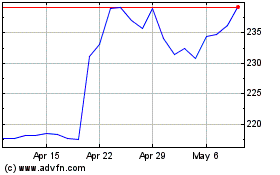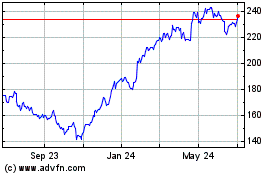AmEx Profit Climbs As Cardholders Spend -- WSJ
April 19 2018 - 3:02AM
Dow Jones News
By AnnaMaria Andriotis and Maria Armental
This article is being republished as part of our daily
reproduction of WSJ.com articles that also appeared in the U.S.
print edition of The Wall Street Journal (April 19, 2018).
American Express Co. reported a 31% increase in first-quarter
profit, driven by a pickup in card holder spending and
borrowing.
The company reported profit of $1.63 billion, or $1.86 a share.
Revenue, net of interest expense, rose 12% to $9.72 billion.
Analysts surveyed by FactSet had projected a profit of $1.71 a
share on $9.13 billion in revenue.
The dollar amount of purchase transactions on AmEx cards
increased 10% from a year prior, adjusting for foreign exchange,
marking the biggest increase in billed business growth for the
company since the third quarter of 2014.
The acceleration appears in large part to be the result of
improved consumer sentiment. "There's clearly something going on
with increased confidence and increased spending" in particular
with more affluent customers, said Jeffrey Campbell, AmEx's finance
chief, on the company's earnings call Wednesday.
The company raised its revenue growth guidance to at least 8%
for 2018, up from a 7% to 8% range. It also said it expects
earnings per share to be at the high end of the $6.90 to $7.30
range it previously stated.
AmEx is focusing on rebuilding its capital, which took a hit
from charges related to the U.S. tax overhaul. A roughly $2.6
billion charge in the fourth quarter of 2017 pushed the company
into its first quarterly loss in a quarter-century, and AmEx
suspended share buybacks for the first half of the year. Quarterly
dividends remain unchanged. Mr. Campbell, on Wednesday's call, said
the company feels "confident that [it] will resume share
repurchases in the second half of the year."
Shares, which have outperformed the market over the past 12
months with a 26% gain, rose 3.5% to $98.45 in after-hours
trading.
AmEx changed chief executives in February after longtime chief
Kenneth Chenault retired, handing over the reins to AmEx veteran
Stephen Squeri. The company is continuing to pursue two of the
bigger strategies put into motion under Mr. Chenault: boosting
revenue by increasing lending to customers and separately lowering
the fees it charges merchants when customers use their cards to pay
for purchases.
On the merchant side, AmEx "discount" revenue from swipe fees
increased 9% from a year prior to $5.9 billion even as its average
swipe-fee rate fell 0.06 percentage point from a year prior to
2.37%. That is part of a broader effort under way at the company to
gain more merchant acceptance and to close the gap it currently has
with Visa and Mastercard.
The company continues to push into lending in the U.S. and
abroad, a departure from its core focus on affluent consumers who
pay their monthly bills in full. Card member loans totaled $72.8
billion world-wide, up 14% from a year prior and slightly down from
the preceding quarter. Loan balances in the U.S. increased 13% from
a year prior to $63.9 billion. That exceeded the rate at which
credit card debt is rising nationwide. In February, total U.S.
credit-card debt increased about 5.5% from a year prior, according
to the latest data from the Federal Reserve.
Loan losses and the amount of money the company set aside to
cover future losses both increased. Its global loan net write-off
rate -- including principal, interest and fees -- edged up to 2.4%
from 2.2% in the preceding quarter and 2.0% a year earlier. Its
total loan loss provisions increased 35% from a year prior to $775
million. AmEx chief Mr. Squeri said in a company statement that
"credit indicators are in line with our expectations."
Expenses rose 9% from the year-ago period, though they were 3%
lower than the preceding quarter. AmEx expenses paid out as
card-members rewards, which includes points redeemed for hotels and
airfare, reached $2.35 billion, its largest single expense and up
3.8% from the fourth quarter of 2017.
An increase in lending should bode well for AmEx and other card
issuers in a rising rate environment. Mr. Campbell, however, in
discussing the company's floating rate debt, said on the earnings
call that the company recently has seen compression in the spread
between its funding rates and the prime rate, "which is putting
more pressure on net interest yields than we had originally
anticipated."
Write to AnnaMaria Andriotis at annamaria.andriotis@wsj.com and
Maria Armental at maria.armental@wsj.com
(END) Dow Jones Newswires
April 19, 2018 02:47 ET (06:47 GMT)
Copyright (c) 2018 Dow Jones & Company, Inc.
American Express (NYSE:AXP)
Historical Stock Chart
From Mar 2024 to Apr 2024

American Express (NYSE:AXP)
Historical Stock Chart
From Apr 2023 to Apr 2024
